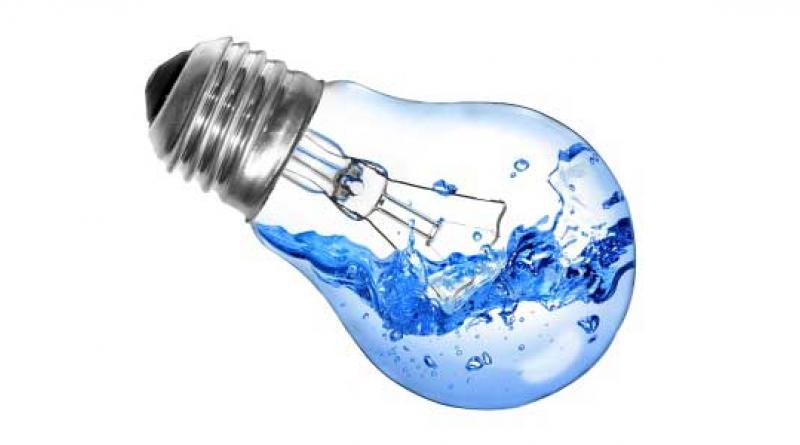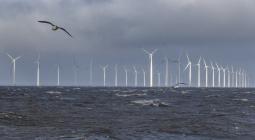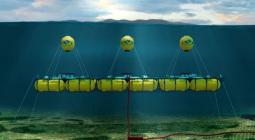Γαλάζια ενέργεια: μπορεί το θαλασσινό νερό να καλύψει όλες τις μελλοντικές ενεργειακές μας ανάγκες;

Blue Energy: can we get all our future energy from salt water?
Forget Nuclear Fusion. There’s a future energy source that has been proven, piloted, and is accessible to any coastal nation. Salinity gradient power — more simply known as ‘blue energy’ — is an idea that has been kicking around since the 1950s. When the mouth of a river meets the sea, huge volumes of freshwater meet salty seawater. As the salinity of the seawater mixes into the freshwater, the two waters diffuse quickly to reach an equilibrium. This mixing process releases energy: as much, in fact, as the same volume of water falling from a 250 meter high hydroelectric dam.
The potential power available was estimated in the 1970s (based on average ocean salinity and global river discharges) to be between 1.4 and 2.6TW a year: enough to meet almost all the entire global electricity demand.
If you place a membrane between the two bodies of water as they meet, you can capture the energy. There are currently two competing methods to do so. One, Pressure Retarded Osmosis (PRO), is similar to a hydroelectric plant: with river water on one side of the membrane and seawater to the other, the flow between the membrane builds up pressure on the seawater side, which can be used to power a turbine (click the video below). In 2009, Norwegian company Statkraft opened a pilot PRO plant in the Oslofjord with a 2000 metre squared membrane, achieving a modest proof-of-concept output of 5KW.
The second method is Reverse Electrodialysis (RED). This doesn’t harness energy from pressure, but instead diverts the ions in the water, creating an ionic current which is converted by the electrodes to electricity. This requires two membranes, effectively creating a seawater sandwich (with freshwater as the bread, and saltwater as the filling). The salt in the water, sodium chloride, is composed of two ions: sodium ion (or Na+, which has a positive charge) and chloride ion (Cl-, which has a negative charge). By sending negative and positive ions in opposite directions, you in effect form a saline battery. Create a big enough bank of these batteries, and you can get a lot of electricity.
Michael Papapetrou, Senior Project Manager at Munich-based WIP Renewable Energies, worked on an EU funded RED project called REAPower, which ran from 2010 to 2014. He tells me that “the performance has been proven to be viable at real conditions and as the technology is modular, scaling up is not a challenge.” Using a membrane created by FUJIFILM, a 1KW pilot site was set up at a saltworks in Marsala, Sicily, with reserves of highly concentrated brine. The higher salinity “allows us to achieve higher power densities”, explains Papapetrou. This also raises the possibility of combining Reverse Electrodialysis power generation with desalination water plants, which currently produce brine water as a waste product.
However, in order to become viable, “this technology, similarly to most innovative energy generation technologies, has to progress through the technology readiness level and reduce costs so that is can be competitive in the market”, says Papapetrou. “Compared to any other energy generation technology (solar, wind, wave and tidal, not to mention nuclear and other fossil fuels), the support that salinity gradient power has received so far is almost negligible.”
The Sicily trial is no longer operating, and the Statkraft Norway PRO plant wasn’t deemed cost-effective, and was similarly shut down in 2013. Papapetrou believes that “salinity gradient power certainly has a role to play in the energy mix of the future… It has the potential to become cost- competitive, there are sites where large power plants can be built, and many more locations where smaller applications are possible. It is a totally controllable source that can be delivered as base load and/or to cover peak demand. It might never compete for becoming the number one energy source and as such it might not be a major, global energy source. But, it has a role to play and it can be valuable.”
In fact, much of the tech used in Sicily (including the FUJIFILM membrane) reappeared in November 2014, when the Netherlands opened a RED power plant on the Afsluitdijk dam (pictured). With seawater on one side of the dam and freshwater on the other, it is the ideal location. Rik Siebers, director of REDstack BV, the Dutch operator, informs me that despite initial teething problems including “the growth of barnacles on the seawater intake”, the plant is now capable of producing 50 KW of power.
There is hope for PRO too. Since the Norway prototype, the focus of PRO research has been improving and developing new membranes. The polymer membranes were deemed too expensive (and, naturally, tend to clog up with salt). In theory, however, carbon nanotube membranes could be 1000 times more efficient than polymer. Siebers also informs that “there is a new initiative in Denmark, testing PRO on a pilot scale and aiming for a upscaling to 1 MW in 2022.”
The most exciting thing about Blue Energy is its potential is evenly distributed across the world. A paper from Wageningen University has identified 123 rivers with “technical potential” for blue energy power generation exceeding 1 GW, across all continents, including Zaire (57 GW), Orinoco (36 GW), Ganges (25 GW), Nile (21 GW), Mississippi (18 GW), St. Lawrence (16 GW), Parana (16 GW), Zambezi (15 GW), and the Mekong (15 GW).
Any country with long coastlines or large salt lakes is an obvious contender. For example, Fernanda Helfer of Griffith University, Brisbane, has proposed that Australia has a significant potential given its proximity of major cities to the ocean, vast salt beds to generate brine, and desalination plants that could be coupled with blue energy plants.
There is even potential for landlocked countries, too. The team that developed REAPower has been working on a new project (RED Heat-to-Power) using artificial salt solutions. “In fact, operating with artificial solutions allows us to define the conditions and optimise the RED performance, achieving much higher power densities”, says Papapetrou. “But in that case, we do not have a natural source of energy and we have to operate in closed loop. For regenerating the salinity difference between the two solutions we use desalination technologies, based on low temperature heat.” The RED heat-to-power application converts low temperature heat to electricity, which means that the blue energy technological developments can be used to benefit any location where waste heat is available; practically any industrial plant in the world.
Blue Energy is the new renewable energy kid on the block. “We started our first tests on a pilot scale in May 2014, almost five years ago”, says Sieber. “Compared to the development time of solar or wind power we are just starting, and we have already made a great deal of progress. When given sufficient time and money, we will continue this progress… since the runoff of rivers isn’t fluctuating on the same timescale as solar and wind power, we believe that Blue Energy can be an important energy source in the future.”
Salinity gradient power, or blue energy, offers a constant energy source that can be switched on and off — until now, that has been the only argument that coal, gas and nuclear have had left to cling to: the Holy Grail of being able to balance the electricity grid, in response to the fluctuating energy production of solar and wind power. Blue energy could yet fill that final missing link in the chain of 100% renewable energy.
29 January 2019
Tim Smedley






